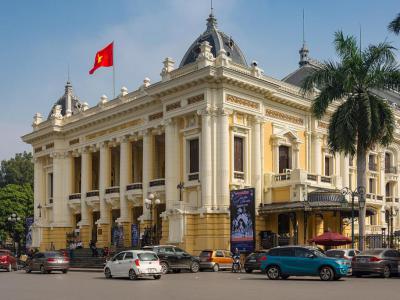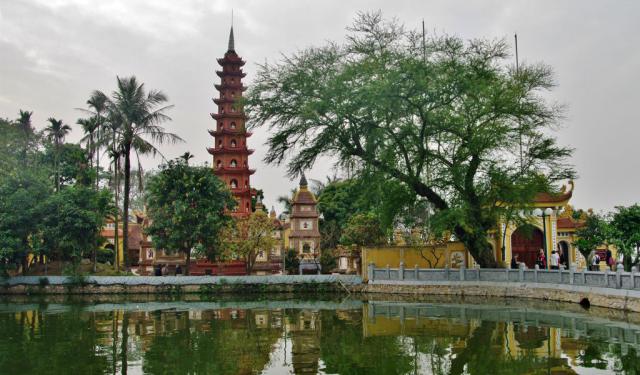Hanoi Opera House, Hanoi
The Hanoi opera house was built in 1911 by the French colonial rulers to resemble the old opera house in Paris. On August the 16th 1945, the Viet Minh declared that it had taken over the city from the balcony of the building.
The Hanoi opera house was built over a drained pond in 1911. Architects Harley and Broyer were the designers, and the construction was supervised by M. Travary and M. Savelon. The structure combines Greek, Beaux Arts and Gothic styles like the Palais Garnier, the old opera house in Paris. This is the largest theater in Vietnam. It consists of a large stage, a 24 x 24 meter main audience room and several balconies in the middle floor. There are 18 makeup rooms, 2 rooms for voice training, a library and a meeting room backstage. In 1997, the opera house underwent major restoration under the supervision of French Vietnamese architects, Ho Thieu Thri and Hoang Phuc Sinh. The theater was equipped with state of the art acoustic and other equipment suitable for modern audiences.
Visitors can view all types of performances at the Hanoi opera house including folk music performances, western music concerts and Vietnamese operetta and drama. Visitors are not allowed in unless they are part of the audience at a performance. The steps leading to the building are a popular place for tourists to get their photographs taken.
The Hanoi opera house was built over a drained pond in 1911. Architects Harley and Broyer were the designers, and the construction was supervised by M. Travary and M. Savelon. The structure combines Greek, Beaux Arts and Gothic styles like the Palais Garnier, the old opera house in Paris. This is the largest theater in Vietnam. It consists of a large stage, a 24 x 24 meter main audience room and several balconies in the middle floor. There are 18 makeup rooms, 2 rooms for voice training, a library and a meeting room backstage. In 1997, the opera house underwent major restoration under the supervision of French Vietnamese architects, Ho Thieu Thri and Hoang Phuc Sinh. The theater was equipped with state of the art acoustic and other equipment suitable for modern audiences.
Visitors can view all types of performances at the Hanoi opera house including folk music performances, western music concerts and Vietnamese operetta and drama. Visitors are not allowed in unless they are part of the audience at a performance. The steps leading to the building are a popular place for tourists to get their photographs taken.
Want to visit this sight? Check out these Self-Guided Walking Tours in Hanoi. Alternatively, you can download the mobile app "GPSmyCity: Walks in 1K+ Cities" from Apple App Store or Google Play Store. The app turns your mobile device to a personal tour guide and it works offline, so no data plan is needed when traveling abroad.
Hanoi Opera House on Map
Sight Name: Hanoi Opera House
Sight Location: Hanoi, Vietnam (See walking tours in Hanoi)
Sight Type: Attraction/Landmark
Guide(s) Containing This Sight:
Sight Location: Hanoi, Vietnam (See walking tours in Hanoi)
Sight Type: Attraction/Landmark
Guide(s) Containing This Sight:
Walking Tours in Hanoi, Vietnam
Create Your Own Walk in Hanoi
Creating your own self-guided walk in Hanoi is easy and fun. Choose the city attractions that you want to see and a walk route map will be created just for you. You can even set your hotel as the start point of the walk.
Hanoi's Old Quarter Walking Tour
The Old Quarter (Vietnamese: Phố cổ Hà Nội) is the name commonly given to the historical civic urban core of the city, located outside the Imperial Citadel of Thăng Long in the northern half of Hoàn Kiếm District, renowned for its small street blocks and alleys, and a traditional Vietnamese atmosphere.
During the Lê dynasty (1428-1789), the area included several lakes and wetlands... view more
Tour Duration: 2 Hour(s)
Travel Distance: 4.0 Km or 2.5 Miles
During the Lê dynasty (1428-1789), the area included several lakes and wetlands... view more
Tour Duration: 2 Hour(s)
Travel Distance: 4.0 Km or 2.5 Miles
Hanoi Introduction Walking Tour
Known for its centuries-old architecture and rich culture with Southeast Asian, Chinese and French influences, the capital of Vietnam, Hanoi, traces its origin back to the third century BC. Originally, a portion of modern-day Hanoi served as the capital of the historic Vietnamese nation Âu Lạc. Following the collapse of Âu Lạc, the city was made part of Han China (111 BC-40 AD).
... view more
Tour Duration: 2 Hour(s)
Travel Distance: 4.0 Km or 2.5 Miles
... view more
Tour Duration: 2 Hour(s)
Travel Distance: 4.0 Km or 2.5 Miles





